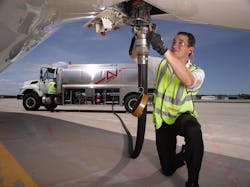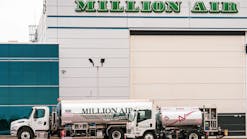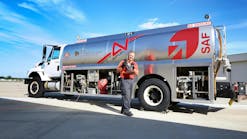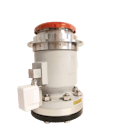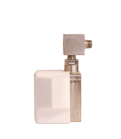Fueling Safety From Refinery to Wingtip: What Really Goes Into Clean, Dry Fuel
Nearly every FBO advertises it, but it is something the aviation community often takes for granted until there is an issue: clean, dry fuel. When fueling an aircraft, we expect the fuel to be nothing less than on specification — after all, for it to be anything but could be harmful to the aircraft, and the pilots and passengers inside. But what does it take to fuel safely with clean, dry product? And how do operations ensure it stays that way? At the end of the day, or the beginning of a trip, selecting an operation that provides quality fuel is more important than saving a few cents a gallon — what’s at stake is far more valuable.
Safe fueling does not just begin when the fuel enters the aircraft — it’s a meticulous process from the moment fuel leaves the refinery, to the moment it is delivered into the plane. But what does that process look like and how is fuel quality ensured along the way?
To start, fuel suppliers like Avfuel have relationships with multiple refiners. In Avfuel’s instance, its supply department arranges for fuel to be delivered from one of more than 90 refineries to one of hundreds of fuel supply terminals via pipeline, truck, barge or rail car. From there, Avfuel’s logistics team — available 24/7/365 out of its headquarters in Ann Arbor, Mich. — arranges for FBOs and airports who order fuel to receive it from a supply terminal via one of Avfuel’s trained over-the-road transport vehicles or common carriers.
Throughout the delivery process — from refiner, to supply terminal to FBO or airport — the fuel has already undergone rigorous testing to ensure it meets industry specifications for quality. When the FBO or airport receives the fuel, it is tested again before being received into storage to avoid any type of contamination. Despite the fuel already being tested multiple times up to this point, the tests are just beginning.
Once in storage, FBO or airport staff members take over. Fuel is tested regularly to ensure contaminants have not compromised its integrity and that the fuel remains clean and dry for use in an aircraft. This is where proper training for FBO and airport staff members is crucial for fueling safety.
For this reason — in response to an industry-wide push for standardized practices, and knowing not all FBOs could afford the steep prices of training programs exasperated by employee turnover and recurrent training needs — Avfuel developed its online learning management system to offer its branded network cost-effective training solutions. In addition to customer service training and front counter training, the online Avfuel Training System includes the Avfuel Rampside Training program (ART), which features 18 lessons and multiple additional downloadable resources concerning fuel handling and safety protocols:
- Fuel Handling and Fire Safety
- Aviation Fuels and Additives
- Fuel System Icing Inhibitor (FSII)
- Contaminants and Fuel Testing Methods
- Procedures for Receiving a Load of Aviation Fuel
- Aviation Fueling Components
- Fuel Storage Systems
- Mobile Refueling Equipment
- Aircraft Fueling and General Operations
- Aircraft Marshalling
- Aircraft Towing Equipment
- Aircraft Towing Procedures
- Record Keeping Best Practices
- De-icing and Anti-icing Introduction
- De-icing and Anti-icing Fluid Handling Procedures
- De-icing and Anti-icing Fluid Application
- General Aviation Security
- Supervisor Sign Off
The Avfuel Training System was designed with FBOs in mind to complement hands-on training initiatives. With video tutorials, proficiency tests and supplemental training guides, it offers a learn-at-your-own-pace format ideal for both new employees and recurrent training needs, making fueling safety education more efficient.
With easily-accessible, comprehensive training tools on hand, flight departments can be assured that line staff is more knowledgeable than ever before in fuel safety: from transferring fuel from storage tanks to refueler trucks, and refueler trucks to the wingtip of the aircraft, ensuring the quality of the fuel every step along the way.
In addition to online training, Avfuel offers an FAA-approved, Part 139 quality assurance and fire safety seminar.
Of course, should an issue ever arise, Avfuel’s quality assurance team is available 24/7/365 to help troubleshoot and solve fuel quality concerns.
But while FBOs have access to more fuel safety tools than ever, it pays for pilots to be proactive in the fueling process and monitor for fuel quality. Here are a few items pilots and flight departments can look for throughout the process; however, this is by no means an exhaustive list.
Certifications: even before selecting an FBO, flight departments can consider which certifications the FBO has received and what type of training its employees complete. In addition to the Avfuel Training System and Avfuel’s FAA-Approved Part 139 Seminar, many FBOs use the NATA Safety First training program or their own training program. Pilots can even ask to see an FBO staff’s fuel quality training certificate to ensure those handling the aircraft are qualified to do so.
Forms and Records: In addition to training certificates, pilots can ask to see the FBO’s inspection forms and fuel quality test records. By doing so, pilots can discern whether or not the FBO has a routine schedule for checking fuel quality, and whether or not those checks were recently completed and up to industry standards. Staff should be running tests on a daily basis and keeping accurate, detailed logs of these processes.
Be Present: Beyond all this, one of the most important safeguards during the line-service process as a pilot is to simply be present. Pilots should keep an eye on the fueling and towing procedures to monitor for proper handling, being aware of their surroundings and noticing some key items:
- Ensure trucks are clearly marked as containing either Jet A or Avgas. This helps safeguard against cross-contamination and reassures pilots the correct fuel is going into their aircraft.
- Look around to notice what is stored inside and out of the facility. For instance, FSII should always be stored inside. Look for spills on the ramp—spills are a sign of negligence when fueling.
- Trucks should remain 10 feet away from aircraft engines and tires should be properly chocked.
These are just a few of the comprehensive items flight departments and pilots should consider when fueling—though simple enough, it’s all too easy to choose an FBO based on price, land the aircraft, let line personnel do their business and take off. However, when dealing with expensive machinery and, more importantly, the safety of others, it pays to be proactive and pay attention.
A properly executed process full of checks and balances from refinery to wingtip ensures fuel is clean, dry and handled properly for the upmost safety in fuel handling. While clean, dry fuel may be taken for granted, from a fuel supplier and FBO perspective, it is never to be taken lightly.
Quality assurance manager, Randy Harrison, brings nearly 30 years of experience in aviation fuel supply logistics to the Avfuel network, including QA inspections and training for distribution terminals, and engineering experience in the design and construction of aviation fuel storage systems and mobile fueling equipment. Throughout his career, Harrison has conducted hundreds of onsite quality control audits and nearly 50 Part 139 training seminars, which have educated thousands of attendees. With his vast experience, Harrison has helped develop and implement an array of training solutions: the Avfuel Quality Assurance FAA-Approved Part 139 Supervisory Training Seminar, the Avfuel Quality Assurance Training Videos and training for Avfuel’s aviation over-the-road carriers.
